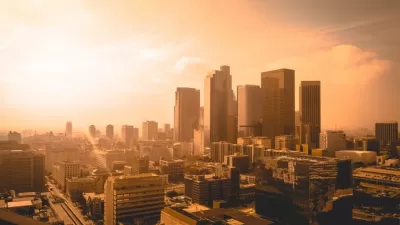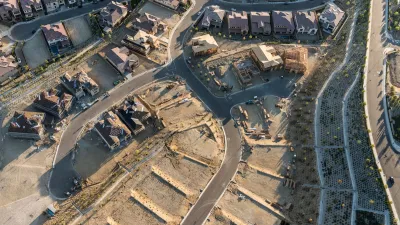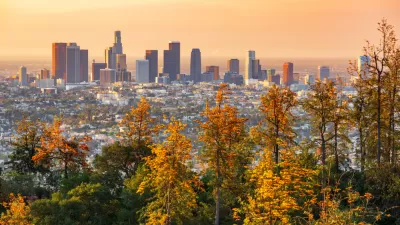Los Angeles appears in Blade Runner 2049 in name only. But the film still provides an arresting vision of a high-density future and is a reminder of the eternal ambiguity that surrounds Los Angeles.

"Blade Runner created a dystopic vision of Los Angeles that remains as culturally potent today — if not more so — than it was when it came out in 35 years ago. It shows up in books, articles, and offhand remarks with astounding regularity. It’s a testament to the arresting visuals of hyper-dense polyglot streets illuminated by sparkling advertisements and the possibility, however slim, that our sunny, spread-out paradise could, someday, become one of the dark places of the earth. After all, perhaps the biggest fantasy to come out of Los Angeles is Los Angeles itself."
"Areal shots depict the city’s familiar endless rows of boulevards and residential streets. The houses that dot Reyner Banham’s Plains of Id are replaced by high-rise shantytowns, made up of apartment buildings, each many stories tall, each more dilapidated than the last. Mere dingbats they are not. In this Blade Runner, the billboards walk the street, as 80-foot tall holograms that shake their asses just for you. (We’ve come a long way from Angelyne.) Skyscrapers rise into the ochre fog, and all is overshadowed by the new citadel of the Wallace Corporation, the corporation that rose from the ashes of Tyrell."
"Interestingly, of all the reasons that Scott might have envisioned for the demise of the world, climate change surely was not one of them. Blade Runner came out in 1982, after all. If anything, he probably had in mind the Cold War, signified by passing references to our them-communist antagonists, Russia and China. So, while the fictional city hasn’t changed much, its allegorical power has changed dramatically, as the real threats to humanity have evolved (and, arguably, worsened)."
FULL STORY: Searching for Los Angeles in Blade Runner 2049

Alabama: Trump Terminates Settlements for Black Communities Harmed By Raw Sewage
Trump deemed the landmark civil rights agreement “illegal DEI and environmental justice policy.”

Planetizen Federal Action Tracker
A weekly monitor of how Trump’s orders and actions are impacting planners and planning in America.

The 120 Year Old Tiny Home Villages That Sheltered San Francisco’s Earthquake Refugees
More than a century ago, San Francisco mobilized to house thousands of residents displaced by the 1906 earthquake. Could their strategy offer a model for the present?

In Both Crashes and Crime, Public Transportation is Far Safer than Driving
Contrary to popular assumptions, public transportation has far lower crash and crime rates than automobile travel. For safer communities, improve and encourage transit travel.

Report: Zoning Reforms Should Complement Nashville’s Ambitious Transit Plan
Without reform, restrictive zoning codes will limit the impact of the city’s planned transit expansion and could exclude some of the residents who depend on transit the most.

Judge Orders Release of Frozen IRA, IIJA Funding
The decision is a victory for environmental groups who charged that freezing funds for critical infrastructure and disaster response programs caused “real and irreparable harm” to communities.
Urban Design for Planners 1: Software Tools
This six-course series explores essential urban design concepts using open source software and equips planners with the tools they need to participate fully in the urban design process.
Planning for Universal Design
Learn the tools for implementing Universal Design in planning regulations.
Clanton & Associates, Inc.
Jessamine County Fiscal Court
Institute for Housing and Urban Development Studies (IHS)
City of Grandview
Harvard GSD Executive Education
Toledo-Lucas County Plan Commissions
Salt Lake City
NYU Wagner Graduate School of Public Service





























